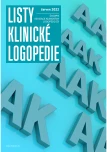ALTERNATIVE AND AUGMENTATIVE COMMUNICATION IN AMYOTROPHIC LATERAL SCLEROSIS PATIENTS
Authors:
Lasotová Naděžda 1; Betík Adam 2; Vlčková Eva 2
Published in:
Listy klinické logopedie 2022; 6(1): 39-45
Category:
Main topic
doi:
https://doi.org/10.36833/lkl.2022.014
Overview
Amyotrophic Lateral Sclerosis (ALS) is a progressive neurodegenerative disease. Among others, dysarthria and dysphagia (i.e. bulbar dysfunction) represent common clinical manifestations of ALS. Gradual impairment or even loss of speech functions puts ALS patients in the position of serious candidates for the implementation of Alternative and Augmentative Communication (AAC). Regular follow-up with the assessment of speech functions and AAC recommendation and settings in the relevant cases provided by the Clinical Speech Therapist are recommended in all ALS patients, from the onset of the disease. Maintaining the possibility of communication and interaction with the family and friends throughout the disease significantly improves the quality of life of patients and their caregivers. The paper presents the results of the long-term follow-up of a group of 89 ALS patients with bulbar impairment, focused on the use of AAC and the timing of AAC onset. Almost one-half of our patients started to use AAC in the follow-up period. Not surprisingly, the AAC methods were used mainly by patients with severe dysarthria or anarthria. In the study sample, patients started to use AAC approximately 16 months after the onset of bulbar symptoms. However, the time to onset of AAC was significantly variable individually, and a few patients did not use any AAC methods, even in the interval of more than 8 years from the onset of clinical bulbar impairment.
Keywords:
Quality of life – Amyotrophic lateral sclerosis – dysarthria – augmentative and alternative communication
Sources
- ANDERSEN, P. M., S. ABRAHAMS, G. D. BORASIO, M. de CARVALHO, A. CHIO, P. Van DAMME, O. HARDIMAN, K. KOLLEWE,
- K. E. MORRISON, S. PETRI, P.-F. PRADAT, V. SILANI, B. TOMIK, M. WASNER a M. WEBER, 2012. The EFNS task force on diagnosis and management of amyotrophic lateral sclerosis. EFNS guidelines on the clinical management of amyotrophic lateral sclerosis (MALS) - revised report of an EFNS task force. European journal of neurology. 19(3), s. 360-375. DOI:10.1111/j.1468-1331.2011.03501.x.
- BARRIGUINHA, C. I. F., M. T. do COMO MOURAO a J. MARTINS, 2017. Communication and swallowing difficulties in palliative patients: patients, families and/or caregivers perspective. Audiol., Commun. Res. 22:e1655. DOI:10.1590/2317-6431-2015-1655. ISSN 2317-6431.
- BEUKELMAN, D., S. FAGER a A. NORDNESS, 2011. Communication support for people with ALS. Neurology research international. 2011 : 714693, DOI: 10.1155/2011/714693.
- BUŽGOVÁ, R., M. BAR, P. BÁRTOVÁ, R. KOZÁKOVÁ, P. RESSNER, L. SIKOROVÁ a R. ZELENÍKOVÁ, 2017. Neuropaliativní a rehabilitační péče u pacientů v pokročilé fázi progresivních neurologických onemocnění. Cesk Slov Neurol N. 81(1), s. 17-23. DOI: 10.14735/amcsnn201717.
- BUŽGOVÁ, R., R. KOZÁKOVÁ, R. ZELENÍKOVÁ a L. SIKOROVÁ, 2018. Přehled dotazníků a škál hodnotících pacienty s amyotrofickou laterální sklerózou. Čas. Lék. čes. 157(1), s. 41-45.
- CREUTZFELDT, C. J., B. KLUGER, A. G. KELLY, M. LEMMON, D. Y. HWANG, N. B. GALIFIANAKIS, A. CARVER, M. KATZ, J. R. CURTIS a R. G. HOLLOWAY, 2018. Neuropalliative care. Priorities to move the field forward. Neurology. 31; 91(5), s. 217-226. DOI: 10.1212/WNL.0000000000005916.
- HANSON, E., K. YORKSTON a D. BRITTON, 2011. Dysarthria in amyotrophic lateral aclerosis: A systematic review of characteristics, speech treatment, and augmentative and alternative communication. Journal of medical speech-language pathology. 19(3), s. 12-30.
- LASOTOVÁ, N., M. DUBOVÁ, E. VLČKOVÁ a R. SLÁMOVÁ, 2020. Bulbární symptomy – dysfagie, poruchy řeči, slintání. In: BUŽGOVÁ, R., R. KOZÁKOVÁ et al. Základy paliativní péče v neurologii. Praha: Galén. ISBN 978 - 80-7492-502-3.
- NICE. National Institute for Health and Care Excellence. 2016, last update 2019. Motor neuron disease: assessment and management. NICE giudeline [NG42]. [online] [cit. 2.3.2022]. Dostupné z: https://www.nice.org.uk/guidance/ng42
- PATTEE, G. L., E. K. PLOWMAN, K. L. FOCHT GARAND, J. COSTELLO, B.R. BROOKS, J. D. BERRY, R. A. SMITH, N. ATASSI, J. L. CHAPLIN, Y. YUNUSOVA, C. E. McILDUFF, E. YOUNG, E. A. MACKLIN, E. R. LOCATELLI, V. SILANI, D. HEITZMAN, J. WYMER, S. A. GOUTMAN, D.F. GELINAS, B. PERRY, P. NALIPINSKI, K. STIPANICIC, M. O´BRIEN, S. L. SULLIVAN, E. P. PIORO, G. GARGIULO a J. R. GREEN, 2019. Provisional best practices guidelines for the evaluation of bulbar dysfunction in amyotrophic lateral sclerosis. Muscle & nerve. 59(5), s. 531-536. DOI:10.1002/mus.26408.
- POLLENS, R., 2004. Role of the speech-language pathologist in palliative hospice care. Journal of Palliative Medicine.7(5), s. 694-702. DOI:10.1089/jpm.2004.7.694.
- POLLENS, R., 2012. Integrating speech-language pathology services in palliative end-of-life care. Top Lang Disorders 32(2), s. 137-148. DOI: 10.1097/TLD.0b013e3182543533.
- RIDZOŇ, P., 2020. Onemocnění motorického neuronu. In: BUŽGOVÁ, R., R. KOZÁKOVÁ et al. Základy paliativní péče v neurologii. Praha: Galén. ISBN 978 - 80-7492-502-3.
- ROUBÍČKOVÁ, J., J. HEDÁNEK a A. STRÁNÍK, 2011. Test 3F: dysartrický profil. Praha: Galén. ISBN 978-80-7262-714-1.
- TOMIK, B. a R. J. GUILOFF, 2010. Dysarthria in amyotrophic lateral sclerosis: A review. Amyotrophic lateral sclerosis. 11, s. 4-15. DOI:10.3109/17482960802379004.
- VLČKOVÁ, E., 2016. Amyotrofická laterální skleróza. Neurol. praxi, 17(6), s. 362-365. DOI: 10.36290/neu.2016.076.
Labels
Clinical speech therapy General practitioner for children and adolescentsArticle was published in
Clinical speech therapy (Listy klinické logopedie)

2022 Issue 1
Most read in this issue
- FACILITATION-SYSTEMIC THERAPY
- PRACTICAL USE OF CORE VOCABULARY AND MODELLING IN AUGMENTATIVE AND ALTERNATIVE COMMUNICATION
- ALTERNATIVE AND AUGMENTATIVE COMMUNICATION IN AMYOTROPHIC LATERAL SCLEROSIS PATIENTS
- THE MOST IMPORTANT PARAMETERS OF BOTTLE NIPPLES CURRENTLY USED IN THE CZECH REPUBLIC FOR FEEDING PRETERM INFANTS WHO ARE HOSPITALISED
